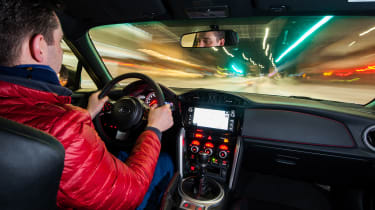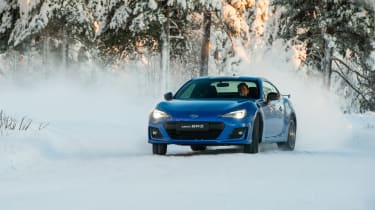Subaru BRZ (2012 - 2021) review – ride and handling
The BRZ’s strongest suit, despite the poor grip and mushy feedback of the standard-fit Primacy tyres. Great balance and precision
Rather than ultimate pace, the BRZ is about low speed thrills and establishing a deep relationship with the car’s mechanical components. The latter goal means that the BRZ isn’t a calm or quiet place to be, and tyre and drivetrain noise are constant – you can even hear the layshaft in the gearbox chuntering away with the engine at idle.
The BRZ’s ride is firm too, and if it wasn’t for a pair of comfortable, well-padded seats that you can move to get the perfect driving position, it would be a rather uncompromising environment to spend time in. But this lack of comfort and refinement is replaced with an exact knowledge of what the car is doing and real understanding of how it might react, which is far more beneficial in a sports car than extreme comfort.
The Subaru feels light and big bumps can cause it to deviate from your desired path, but as the BRZ is also small and narrow there’s usually plenty of room on the road for it not to be nudged into a dangerous position. Its lack of mass helps the body feel incredibly well controlled, and no matter how fast you travel over the harshest of crests the body reacts with minimal fuss.
For the 2017 model Subaru altered the BRZ’s dampers to reduce body roll, but the changes are minor and the car feels much like the BRZ always has done. On the road there’s no hint of understeer, and every tweak of the steering wheel makes the car rotate. This dogged intent to turn rather than roll is impressive but can be slightly unnerving thanks to Subaru trying to minimise the BRZ’s traction with thin, low-grip tyres.
The only time you don’t feel intimately connected with the road is just after turn-in; the steering points the nose exactly where you want it but you’re left hoping the rear tyres will grip. For the most part, and when you want it to, the BRZ does find enough grip, but that brief moment when you aren’t sure is worrying and contrary to the way the rest of the car feels.
This is something that, in our experience, can be fixed with more appropriate tyres than the standard, low-grip Michelin Primacy rubber. We get what Subaru was going for with the set-up it chose, but what you gain in skating around at low speeds, you lose in steering feel and precision, as well as cold- or wet-weather grip. Better tyres don’t kill the car’s adjustability either – if anything, they just make it more predictable.




